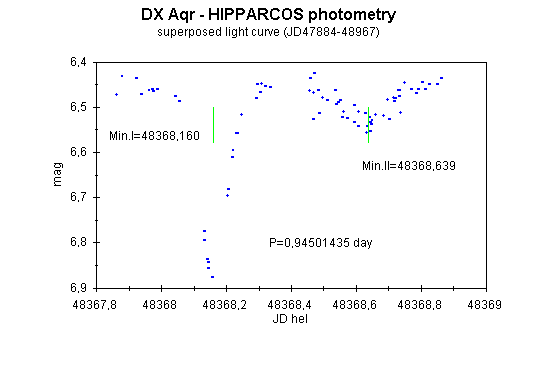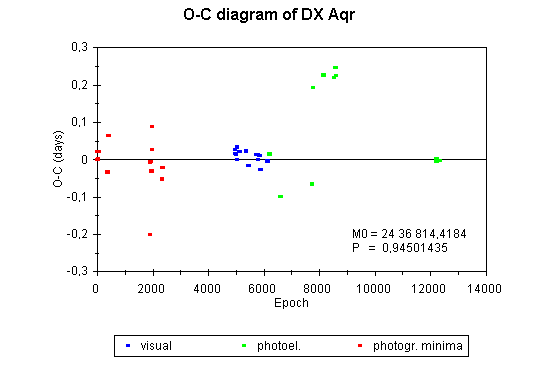
| Go back to Sun Hill Observatory |
SHON - Poster paper
Eclipsing binary DX Aqr
DX Aqr = 29 Aqr = BD -17° 6422 = HD 209 278 = HR 8396 = ADS 15 562B = BV 600 = GSC 6376.1658 = HIP 108 797.
Position: R.A.(2000) = 22h 02m 26.25s, Decl.(2000) = -16° 57' 53.4".
Spectral type: A2. Mean brightness: approx. 7.5 mag V. It is a component of the visual binary ADS 15 562.
The visual binary ADS 15 562 has been observed many times since 1866. But nobody had noticed its variability until W. Strohmeier, R. Knigge, and H. Ott (1965, IBVS No. 81) announced that one of its components is an eclipsing binary. The variability was discovered on the sky patrol plates of Bamberg Southern Station which did not enable to resolve the two visual components.
Despite this fact the variable got its name DX Aqr. It was included into the third edition of GCVS (1969) without specification to which component of ADS 15 562 the name DX Aqr belongs. The fourth edition of GCVS (1985) clearly states that DX Aqr is ADS 15 562B, i.e. the preceding (western) component of the visual binary. However, some misidentifications still occur in the literature. Even in the SIMBAD database (CDS, Strasbourg) the variable is misidentified and the name DX Aqr is related with the component ADS 15 562A instead of the component B.
Soon after the discovery, W. Strohmeier (1966, IBVS No. 164) found out that DX Aqr is an eclipsing binary of the beta Lyrae-type. He determined 12 photographic times of minima and the following light elements:
Min. I = JD hel 24 36 814.440 + 0,945006 x E.
Then K. Locher obtained 14 visual times of minima during the interval 1972-1975 (BBSAG Bull. Nos 4-6,7,11,12,16-19,23). First photoelectric photometry of DX Aqr was done by E. H. Olsen (1976, IBVS No. 1199) who gave the improved elements:
Min. I = JD hel 24 42 687.697 + 0,9450132 x E.
W. Paffhausen and W. Seggewiss (1976, Astron. Astrophys., Suppl. Ser., 24, 29-34) observed DX Aqr spectroscopically, determined a radial velocity curve of the primary component (lines of the secondary component were not visible in the spectra), and combining their spectroscopic data with earlier minima timings they derived the elements:
Min. I = JD hel 24 36 814.4184 + 0,94501435 x E.
Within the next five years (1976-1981) R. K. Srivastava and B. K. Sinha (1985, Astrophys. Space Sci., 111, 225-236) and R. K. Srivastava (1985, Astrophys. Space Sci., 113, 333-340) obtained altogether seven new photoelectric times of minimum light which did not agree with the above mentioned elements. This led them to the calculation of the following light elements:
Min. I = JD hel 24 36 814.440 + 0,472502 x E (Srivastava, Sinha, 1985, ASS, 111, 225)
Min. I = JD hel 24 36 814,440 + 0,4605944 x E (Srivastava, 1985, ASS, 113, 333)
Min. I = JD hel 24 36 814.440 + 0,461700 x E (Srivastava, 1986, ASS, 124, 397)
Surprisingly, this bright eclipsing binary has not been observed since that time so there is a large gap in the series of minima timings. The exception represent measurements made by the HIPPARCOS satellite which yielded a few new times of minima.
In Figure 1 we present a superposed light curve of DX Aqr based on the HIPPARCOS data (these data kindly provided us Dr. M. Wolf of the Astronomical Institute of Charles University in Prague). The times of minima were determined by P. Molik.

Figure 2 shows an O-C diagram of DX Aqr. Most of the photoelectric minima timings are probably wrong. The last (HIPPARCOS) minima suggest that the orbital period of this eclipsing binary has been constant since 1965.

We call attention to this star for two reasons:
1. There are no ground-based observations of minimum light of DX Aqr for more than 16 years. In order to prove or disprove the constancy of its orbital period further minima timings are necessary.
2. Up to now, in all cases the brightness of DX Aqr has been measured together with the second component of the visual binary which has the separation of 3.7 arcseconds and approximately the same brightness but later spectral type (K0 III). Even the only reliable light curve obtained by HIPPARCOS (see Figure 1) represents the visual binary as a whole (amplitude 6.4 - 6.9 mag). Without knowing the light changes of DX Aqr alone the determination of geometrical and physical parameters of this system is not possible.
We bear in mind that DX Aqr is not photometrically easy object but observers (preferably with telescopes having larger focal length) could succeed with it.
Petr Molik, Petrin Hill Observatory, Prague, Czech Republic
Anton Paschke, Rueti, Switzerland
SHON - Contents:
| Go top |